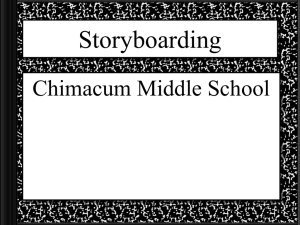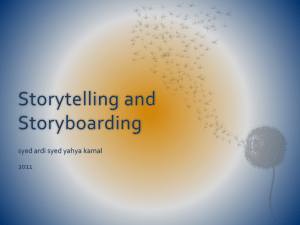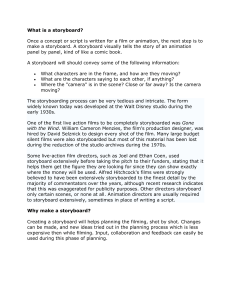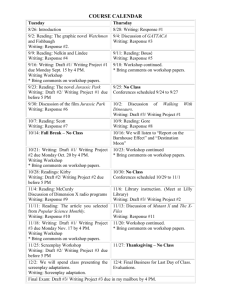Screenplay Stage play
advertisement
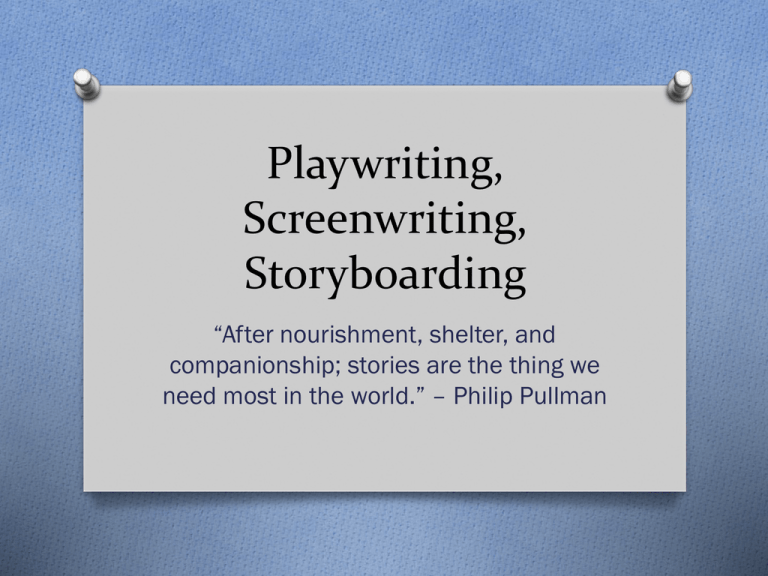
Playwriting, Screenwriting, Storyboarding “After nourishment, shelter, and companionship; stories are the thing we need most in the world.” – Philip Pullman Vocabulary O Plot: the arrangement of the incidents that take place O O O O O in a play. Exposition: detailed information revealing the facts of the plot. Climax: turning point in the action of a play. Antagonist: the character opposing the protagonist. Theme: the basic idea or purpose of the play. It ties together all the characters and events. Spectacle: all visual elements of production, such as scenery, properties, lighting, costumes, makeup, stage movement, and dance. Vocabulary O Act: major division of a play. O Tragedy: a play that deals with a serious situation in a serious way. The protagonist dies or is defeated at the end of the play. O Comedy: a play that presents its theme and characters in a humorous way. All characters come together at the end of the play. O Melodrama: an exaggerated, fast-moving play in which action is more important than characterization. The “good guys” win and the “bad guys” are punished. Vocabulary O Cues: the dialogue, sounds, movement, or business signaling an actor or technician to respond as rehearsed. O Subtext: the underlying meaning or interpretation of a line, which is not indicated in the script but is supplied by the actor. O Business: small movements and actions that do not require the actor to move from place to place. O Storyboard: a sequence of drawings, typically with some directions and dialogue, representing the shots planned for a movie or television production. Lesson Objectives O Understand the O Learn how to analyze dramatic structure of a play. O Recognize several types of plays. O Understand how a play is organized. a play. O Develop a screenplay. O Create a storyboard for film/television. The Structure of Plays O A play is a story written in dialogue form to be acted out by actors before a live audience as if it were real life. O Plays have distinguishing characteristics that make up the play’s dramatic structure. The Elements of a Play O The six basic parts of dramatic structure: O Plot O Language O Character O Music O Theme O Spectacle Guess the Themes O Adventure O Friendship O Courage O Dreams O Empowerment Guess the Themes O Friendship O Youthful Exuberance O Naivety O Acceptance O Baseball Guess the Themes O Memory and the O O O O O O Past Fear Good vs. Evil Friendship Time Family Justice and Judgment The Maltese Falcon The following is a clip from the motion picture The Maltese Falcon. This style of cinema is known as “film noir,” French for “black film.” This is a style that refers to mostly black and white films that contain bleak subject matter and a somber tone. O Pay close attention to the style of the voice, which is easily recognizable for this cinematic genre. O Diction / Language Song / Music O Song / Music is easily identifiable for its explicit use in the genre of musical theatre or cinema. O It should be noted though, that song / music does not pertain just to actual singing itself. It includes the use of background music, sfx, or the voices of the actor(s) as well. O The following clip is from Singin’ In The Rain starring Gene Kelly, Donald O’Connor, and Debbie Reynolds. Song / Music Spectacle O The following is a clip from the movie Transformers. O Take note of how the camera angles help enhance the characteristic of spectacle to the scene. Spectacle Analyzing & Researching the Play O Here are some questions to consider in analyzing the play: O What were the major world events at the time of the play? O What were the social customs of the time? O What type of clothing was worn? O What music was popular? O What famous political or social characters were popular? O In what type of dwelling or shelter would the characters have lived? O What type of food was eaten? O What are the job opportunities for the characters? O What is the character’s relationship to society? Analyzing & Researching the Play O It is important to understand the meaning behind the words and actions of each line. This is called subtext. O How does subtext affect the character’s objectives, obstacles, and tactics? O How are the lines different from the actions? (Remember: it’s a stronger choice to judge a character by their actions, not by the words they say.) Analyzing & Researching the Play O As you begin to work on your screenplay and storyboard, visualize the characters’ movements and personal business (mannerisms, actions, or use of props). Screenplays O Screenplays are a bit different from stage plays. They both contain directions, however, in a screenplay the directions focus mainly on the view of the camera. O No longer are we dealing with stage right, stage left, etc. O We must now become accustomed to highangle shot, low-angle shot, cut to, interior, exterior, etc. Screenplay Examples O Notice how everything is mainly centered in a screenplay. Screenplays vs. Stage Plays What differences / similarities do you notice? Screenplay Stage play Storyboarding O A storyboard is a sequence of drawings, typically with some directions and dialogue, representing the shots planned for a movie or television production. Much like a comic strip. O However, a storyboard for a film specifically has additional markings to show the camera angles or directions of camera movements. O A storyboard is absolutely necessary to filmmakers. Think of it as a game plan of how the film is going to be shot. Storyboarding Storyboarding Storyboarding Storyboarding Storyboarding Storyboarding Storyboarding Storyboarding Essential Questions 1. Explain the elements that make up the dramatic structure of a play. 2. How does researching the play benefit all collaborators working on the project? 3. What is the purpose of a storyboard? Project O Your group will need to pick a short scene (2-3 minutes in length) from a film or television show (school appropriate) in which you will reshoot it shot for shot. Make sure that you are choosing something you like, because you will be working on this for the next three units in class. O You will need to create a rough copy of the script. Be sure to include necessary screenplay vocabulary using the screenplay vocabulary worksheet. O You will each need to storyboard 6 shots of the scene. Be sure to include bits of dialogue from the scene, at the bottom of the picture to show what part of the scene the storyboarded shot is from. Also include all necessary arrows to show the direction of camera movement within the scene. O Your storyboard does not have to be colored, but it must be neat and convey a clear story.
